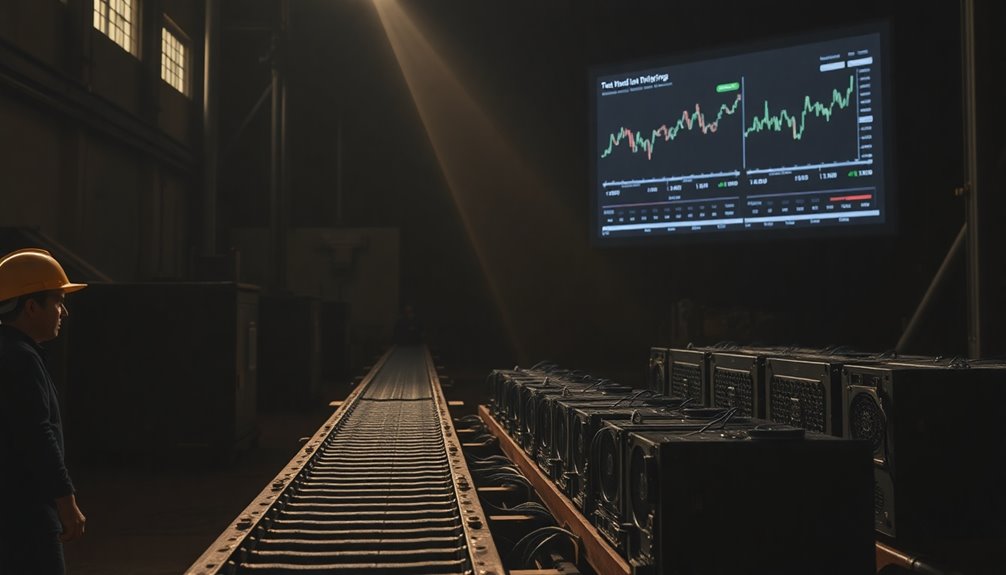Foundry's recent layoffs of 27% in its workforce reflect a tough decision to refocus on its core Bitcoin mining operations amid significant market challenges. With mining revenue dropping 57% since March, Foundry's shift towards its Bitcoin mining pool is essential. It now commands about 30% of the global Bitcoin network's hash rate. While self-mining is projected to generate $80 million in 2024, the company faces rising costs and increasing competition. Despite these hurdles, Foundry aims to sustain profitability and adapt strategically. To learn more about its survival tactics and future plans, read on.
Key Takeaways
- Foundry's workforce was reduced by 27%, streamlining operations to enhance profitability amid financial pressures in the cryptocurrency market.
- The company is pivoting towards its core business of Bitcoin mining pools, where it holds a 30% market share and significant revenue potential.
- Self-mining is projected to generate $80 million in revenue for 2024, indicating resilience despite challenging market dynamics and rising operational costs.
- Foundry plans strategic investments in AI and optimized hardware to improve efficiency and maintain competitiveness in an evolving industry landscape.
- Despite market challenges and internal restructuring, Foundry aims to solidify its leadership position as the world's largest Bitcoin mining pool.
Recent Layoffs Overview

Foundry recently faced a significant shake-up, reducing its employee count from 274 to 200, which translates to a 27% cut. This decision impacted about 74 employees, with around 16% of them based in the U.S. Initial reports mistakenly claimed a staggering 60% reduction, but Foundry management later clarified the actual figures.
The layoffs touched on various business lines, including self-mining, custom hardware, ASIC repairs, site operations, firmware, and decentralized AI infrastructure. Foundry is making these adjustments as part of a strategic move to focus on its core revenue lines amid ongoing restructuring.
While the hardware line is being deprioritized, it hasn't been entirely gutted as some had feared. The ASIC repair business will remain intact, and both site operations and self-mining are still key focus areas.
These layoffs are part of Foundry's strategic pivot to concentrate on core business operations, aiming to better align with the development of DCG's new subsidiaries.
This move reflects broader trends in the crypto industry, as many firms, like Kraken, have also announced significant layoffs.
Despite the reduction in workforce, Foundry's self-mining segment is projected to generate $80 million in revenue for 2024, signaling potential resilience amidst these challenging times.
Strategic Business Restructuring

As Foundry undergoes strategic business restructuring, you're seeing a clear shift towards focusing on its core operations, particularly the Bitcoin mining pool and ASIC repair services. By deprioritizing custom hardware initiatives, Foundry's aiming to stabilize its market position and financial health. Additionally, the spin-off of Yuma reflects a strategic pivot that allows Foundry to concentrate on its primary business lines while still supporting innovative ventures. This restructuring comes in the wake of layoffs that impacted 27% of employees, underscoring the urgency of Foundry's realignment efforts.
Core Business Focus
In a decisive move to enhance operational efficiency, Foundry has undergone a significant workforce reduction, trimming its staff from 274 to 200 employees. This 27% cut focuses on reinforcing core operations, primarily targeting its Bitcoin mining pool and site operations.
The layoffs impacted both US and international teams, with 16% of affected employees based in the US.
By prioritizing its Bitcoin mining pool, which accounts for 30% of the Bitcoin network's total hash rate, Foundry aims to solidify its position as the world's largest mining pool. This segment remains the company's standout business line, with projections indicating that self-mining could generate $80 million in revenue for 2024. Additionally, this strategic move comes amidst broader financial challenges faced by DCG's subsidiary Genesis, which filed for bankruptcy amid FTX fallout.
Furthermore, site operations are a crucial aspect of Foundry's restructuring, ensuring the company maintains its status as an institutional-grade mining partner. These operations are essential for supporting mining activities and will continue to receive focused investment.
This strategic realignment not only strengthens Foundry's revenue-generating capabilities but also aligns with Digital Currency Group's broader restructuring efforts, facilitating the development of new initiatives like Yuma, a decentralized AI startup.
ASIC Repair Retention
With the recent workforce reduction aimed at streamlining operations, the decision to eliminate the ASIC repair and hardware teams underscores a significant shift in strategy. By cutting these teams, Foundry is signaling a commitment to focus on its core revenue-generating operations. This isn't just a random decision; it aligns with a broader restructuring effort to maintain profitability amid financial challenges, including defaults on ASIC-backed loans. Additionally, this strategic decision is crucial for the company to establish clear savings goals that can help ensure its long-term financial health. Automation of security protocols is one of the methods Foundry could consider to enhance operational efficiency.
The operational consequences are immediate—the ASIC repair services are no longer available. However, the move allows Foundry to concentrate on its flagship Bitcoin mining pool and self-mining division, which continues to thrive. Despite these changes, the company has an expected revenue from its self-mining business projected at $80 million by 2024.
Even with a drastic reduction in headcount from over 250 to around 80-90 employees, Foundry still holds a dominant position in the Bitcoin mining industry, accounting for 30% of the network's total hashrate. This strategic pivot reflects Foundry's need to navigate the turbulent waters of the cryptocurrency market while ensuring stability and profitability.
Yuma's Strategic Pivot
Yuma's strategic pivot represents a significant shift for Foundry and its parent company, DCG, as they embrace the emerging potential of decentralized AI technologies. Launched by DCG and backed by Foundry's AI-focused division, Bittensor, Yuma aims to transform the fragmented AI landscape. It's designed to help businesses and startups build innovative applications on the Bittensor network.
As part of Foundry's restructuring plan, about 20 employees have transferred to Yuma, enhancing its capacity to advance decentralized AI solutions. This transfer signifies a reallocation of resources within DCG, aligning with the company's strategy to diversify into emerging technologies like AI. Additionally, this restructuring mirrors Intel's spin-off of its foundry business to enhance competitiveness, showcasing a trend in the tech industry towards specialization. AI software engineer jobs are becoming increasingly critical as companies pivot to integrate AI into their operations. By leveraging predictive modeling techniques, Yuma can further tailor its AI solutions to meet specific client needs. Furthermore, the integration of adaptive learning technologies will ensure that Yuma's applications are continually optimized for user engagement. Moreover, Yuma's approach will prioritize risk management strategies to navigate the uncertainties of the tech landscape effectively.
Yuma's formation leverages Foundry's expertise and resources, integrating seamlessly into DCG's broader strategy. This pivot not only responds to industry trends favoring blockchain-based AI but also positions Foundry and DCG to stay competitive in a volatile market.
Financial Pressures on Mining

As a miner, you're likely feeling the sting of reduced revenues from the upcoming Bitcoin halving, which cuts rewards in half. Coupled with rising operational costs, especially for energy, staying profitable is becoming a real challenge. You'll need to rethink your strategies to navigate these financial pressures and maintain your foothold in the industry. Many miners are now exploring diversification strategies to enhance their revenue streams and mitigate the impact of these challenges. Additionally, some are considering Gold IRAs as a potential avenue for securing their investments against market volatility. Implementing strategies for risk assessment can help miners adapt to changing market conditions and protect their investments. Furthermore, understanding the compliance requirements associated with cryptocurrency investments can provide miners with an added layer of security and confidence in their financial decisions. Utilizing a trusted custodian for IRA management can also help ensure the security of your cryptocurrency investments. By incorporating regulatory compliance, miners can better navigate the complexities of both cryptocurrency and precious metals investments.
Revenue Decline Challenges
The financial pressures on mining operations have intensified amid a stark revenue decline, highlighting the urgent need for miners to adapt. August saw mining revenue drop to $827.56 million, a 10.5% decrease from July and a staggering 57% drop from March's peak. This decline coincided with an all-time high in mining difficulty, which climbed to 89.47 trillion, leading to fewer Bitcoins mined—down from 14,725 in July to 13,843 in August. Moreover, reduced transaction volumes and fees further exacerbate the situation. By the end of August, daily confirmed transactions averaged 594,871, down from 631,648 at the end of July. With median fees making up only 2% of block rewards, miners struggled to offset their declining revenues. The looming Bitcoin halving, which will cut mining revenue by 50%, adds another layer of complexity, forcing miners to find new ways to remain profitable.
To weather these challenges, some miners are exploring alternative revenue streams, such as supporting AI and high-performance computing. This strategic shift could potentially release significant value, helping miners adapt to the harsh financial landscape. Mining difficulty continues to rise, compounding the challenges faced by miners in maintaining profitability.
Rising Operational Costs
Rising operational costs are squeezing miners' profit margins and threatening their viability in an already challenging market.
The financial landscape for Bitcoin mining has shifted dramatically, especially after the April 2024 halving, which reduced rewards and increased difficulty. Current models predict total network hashrate growth to 765 EH/s, making competition even more intense. You're now grappling with costs that can hit as high as $96,100 per Bitcoin, compared to just $19,344 last year. With energy prices skyrocketing, it's essential to adapt to survive.
Here are three key factors driving these rising costs:
- Increased Mining Expenses: Average costs to mine a Bitcoin surged to $51,887, a substantial jump from previous years.
- Energy Pressures: The primary operational expense is energy, and rising prices are squeezing your margins, especially if you lack access to cheaper sources.
- Halving Impact: The halving event has halved your block rewards, pushing many miners toward the brink of profitability.
To navigate this storm, you might need to explore diversification or even consolidation with larger firms that can afford the necessary upgrades and efficiencies.
Your survival may hinge on strategic adjustments in this highly competitive market.
Market Dynamics and Trends

Steering through the complexities of Bitcoin's market dynamics reveals a landscape defined by soaring prices and shifting regulatory frameworks. Steering through the complexities of Bitcoin’s market dynamics reveals a landscape defined by soaring prices and shifting regulatory frameworks. As digital currencies gain mainstream attention, the ecosystem faces increasing scrutiny, bringing ripple stablecoin regulatory challenges to the forefront of industry discussions. Navigating these hurdles requires a delicate balance between innovation and compliance, as stakeholders work to align emerging technologies with evolving legal and financial standards.
As you observe Bitcoin's price surge of 150% entering 2024, it's hard to ignore its near $70,000 mark by late May and an all-time high of $73,000 in March. The recent approval of spot Bitcoin ETFs has markedly boosted market confidence, leading to its current price around $95,570 as it consolidates below the record high.
Predictions suggest Bitcoin could reach $77,000 by the end of 2024 and even hit $123,000 by 2025, influenced by events like the halving and political changes. Previous Bitcoin halving events have historically correlated with price increases, with gains of 51% (2016) and 83% (2020).
Institutional interest is also rising, further fueling Bitcoin's value. However, competition is heating up, with Binance facing challenges from exchanges like OKX, Bybit, and Coinbase, while decentralized exchanges are capturing more of the market.
Looking ahead, global liquidity and political factors will likely impact Bitcoin's performance, especially with the upcoming US elections.
Depending on the election results, Bitcoin's price could fluctuate markedly, reflecting the intricate interplay of market dynamics and external influences.
Impact on Mining Operations

Maneuvering the impact on mining operations reveals a mixed bag of challenges and opportunities for Foundry.
Despite the massive layoffs, the company's Bitcoin mining pool remains operational, contributing to 30% of the network's total hashrate. This core business line continues to thrive, even as Foundry focuses on essential revenue-generating activities.
Here's what you need to know about the current landscape:
- Mining Pool Resilience: Foundry retains its position as the world's largest Bitcoin mining pool, ensuring stability amid restructuring.
- Self-Mining Focus: With expectations of generating $80 million in revenue by 2024, self-mining operations remain critical to Foundry's business strategy. Additionally, the company accounts for 30% of the global Bitcoin mining hashrate, underscoring its significant influence in the market.
- Streamlined Operations: The layoffs of the ASIC repair and hardware teams reflect a strategic shift away from non-core functions, allowing the company to concentrate resources on its mining and firmware divisions.
While significant changes have occurred, Foundry's commitment to mining operations is evident.
Foundry's Position in the Industry

Foundry's Position in the Industry
Frequently recognized as a leader in the cryptocurrency sector, Foundry holds a commanding position in the Bitcoin mining industry. As the largest Bitcoin mining pool globally, it accounts for an impressive 30% of the total Bitcoin network's hashrate. Founded in 2017 and a part of the Digital Currency Group (DCG), Foundry empowers institutional miners and staking customers, cementing its influence.
The company operates the #1 mining pool while expanding its site operations business. Amid restructuring, Foundry maintains a laser focus on its core business lines, deprioritizing non-essential activities like hardware repair. It offers competitive mining pool fee rates, including 0% fees for large clients, ensuring miner success through end-to-end services. Additionally, the company is expected to generate $80 million in revenue from its self-mining business by 2024, reflecting its commitment to strengthening core operations.
Moreover, Foundry emphasizes sustainability, with approximately 71% of its hashrate sourced from ESG-positive energy. Its commitment to decentralization and community development, exemplified by initiatives like the Mining Engineer Fellowship, reinforces its market position.
DCG's Broader Challenges

DCG faces a myriad of challenges that threaten its stability and future in the cryptocurrency landscape. The fallout from the 2022 crash has left DCG grappling with significant financial struggles, legal issues, and operational upheaval.
Here's a closer look at what they're dealing with:
- Financial Pressures: With $1.1 billion in liabilities from Genesis and potential clawbacks from FTX, the financial strain is immense. Grayscale's performance is crucial, as it represents a significant portion of DCG's revenue, particularly because Grayscale is a subsidiary of DCG, which magnifies its financial importance.
- Legal and Regulatory Scrutiny: U.S. authorities are investigating financial transfers between DCG and Genesis, while lawsuits over unpaid loans add to the legal turmoil. The complex aftermath of FTX's collapse continues to complicate matters.
- Operational Restructuring: Layoffs across subsidiaries, including a 30% reduction at Genesis, highlight the need to streamline operations.
Foundry's focus on core services and new business lines like decentralized AI underscores the urgency for adaptation.
These multifaceted challenges put DCG's future in jeopardy, forcing it to navigate a precarious path in a volatile market.
Future Outlook for Foundry

As Foundry looks ahead to the future, it's poised to capitalize on its strong position in the Bitcoin mining industry while addressing the challenges ahead. With a projected revenue of nearly $80 million from self-mining by 2024, the company is focusing on its core operations, including its leading Bitcoin mining pool, which holds about 30% of the global market share. The decision to implement a 27% workforce reduction reflects a commitment to enhancing operational efficiency.
To guarantee sustainable growth, Foundry is implementing strategic cost reductions, including a 27% workforce reduction and a shift away from hardware production. This reallocation of resources will allow the company to enhance its mining pool and firmware offerings, while also investing in new technologies like AI and optimized hardware solutions for greater efficiency.
Here's a snapshot of Foundry's future outlook:
| Key Focus Areas | Expected Outcomes |
|---|---|
| Self-Mining Revenue | Nearly $80 million by 2024 |
| Market Share | 30% of global mining pools |
| Workforce Optimization | 27% reduction in headcount |
| Technological Advancements | Improved efficiency and cost savings
Key Takeaways From the Reset

Foundry's recent restructuring brings several key takeaways that highlight its strategic pivot. The company is making tough decisions to focus on its core operations while maneuvering financial challenges. Here's what you need to know:
- Workforce Reduction: Foundry laid off about 27% of its workforce, impacting 74 employees. This move primarily affected the ASIC repair and hardware teams, streamlining the company to better align with its core focus.
- Strategic Shift: The emphasis is now on Bitcoin mining pool operations and site management. Custom hardware initiatives have been deprioritized, reflecting a clear commitment to strengthening its market position. Additionally, Foundry remains the largest Bitcoin mining pool globally, solidifying its influence in the industry.
- Financial Resilience: Despite the layoffs, Foundry continues to generate significant revenue, expecting $80 million from its self-mining operations in 2024. It remains a key player, accounting for 30% of the Bitcoin network's total hash rate.
These takeaways underscore Foundry's determination to adapt and survive in a challenging market, ensuring its role in the Bitcoin mining sector remains pivotal even amid restructuring efforts.
Frequently Asked Questions
What Specific Business Lines Were Impacted by the Layoffs?
The layoffs impacted several business lines within the company.
You'll notice a 27% reduction in workforce, affecting multiple teams.
The custom hardware division faced a deprioritization, leading to a decreased focus, although it wasn't entirely eliminated.
However, the Bitcoin mining pool, which accounts for 30% of the Bitcoin network's total hash rate, remains unaffected, continuing to serve as a crucial revenue stream for the company.
How Will Layoffs Affect Employee Morale and Company Culture?
When the axe falls, it leaves a chilling silence in the air.
Layoffs can crush employee morale, leading to a staggering decline in job satisfaction and productivity. As trust in leadership erodes, communication falters, and the workplace atmosphere turns toxic.
You may feel overwhelmed by increased workloads and stress, which can ignite burnout.
This disruption doesn't just affect individuals; it reverberates through company culture, stifling innovation and tarnishing your organization's reputation.
What Support Is Available for Laid-Off Employees?
When you face a layoff, several support options are typically available.
Companies often provide severance packages, which may include financial compensation and health insurance continuation.
Outplacement services can help you with resume writing, interview prep, and job searches.
Additionally, some organizations offer emergency financial aid for immediate expenses.
Networking opportunities and access to industry events can connect you with potential employers, enhancing your chances of finding a new job.
What Are the Long-Term Goals of the Restructuring?
The long-term goals of the restructuring focus on strengthening core operations and enhancing revenue generation.
You'll notice a push towards optimizing the Bitcoin mining pool and expanding site operations.
By maintaining key divisions and eliminating non-essential teams, they're streamlining efforts to align with broader industry trends.
Your aim is to foster resilience amidst market volatility, ensuring sustainable growth while adapting to challenges in the cryptocurrency landscape.
It's all about creating a lean, efficient future.
How Does Foundry Plan to Innovate Amid Financial Pressures?
You'll see Foundry innovate by embracing artificial intelligence, streamlining operations, and launching new ventures.
By integrating cutting-edge technology, you'll reduce costs and enhance efficiency.
As they focus on core operations, you can expect a strong push toward self-mining and collaborative projects.
Foundry's commitment to diversifying its strategies guarantees that you'll witness a proactive approach, aiming to navigate financial challenges while maintaining their position in the evolving Bitcoin landscape.
Conclusion
In the face of massive layoffs and strategic shifts, Foundry's charting a stormy sea. While the financial pressures on mining are relentless, their core focus might just be the lighthouse guiding them through. If they can adapt to the changing market dynamics, they'll not only survive but potentially thrive. As they steer through these turbulent waters, staying resilient and responsive is key to emerging stronger in the ever-evolving crypto landscape.










